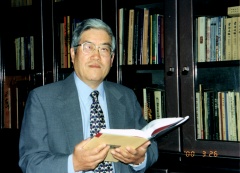Liu Qingzhu
Professor and Director of the Institute of Archaeology, Chinese Academy of Social Sciences (IACASS).

Born in 1943 in Tianjin, professor Liu graduated from the Archaeology Program, Department of History of the Beijing University in 1967. He had been the vice director and director of the Xi’an Research Office of the IACASS, head of the Department of Han to Tang Dynasty of the IACASS, deputy director of the IACASS and the Academic Committee of the IACASS, and now is the director of the IACASS, the Academic Committee of the IACASS, and the High Academic Position Evaluation Committee of the IACASS, head of the Archaeology Department of the Graduate School of the CASS and supervisor of Ph.D candidates. He is also the director of the editorial board of Kaogu and Kaogu xuebao, chief editor of Kaogu, Kaogu xubao, Kaoguxue jikan, Chinese Archaeology (English edition), Kaoguxue nianjian ( Annual of Chinese Archaeology), and the History and Relics part of the second edition of Zhongguo dabaike quanshu (Encyclopedia of China). He owns the title “National Outstanding Specialist” and enjoys Special Allowance of the Government paid by the State Council. He was elected as the Secretary-General of the Archaeological Society of China, member of the executive council of the Historical Society of China and communication academician of the German Archaeology Institute.
His fieldworks in the 1970s include: directing the survey and coring at the Xianyang site – capital city of the Qin Dynasty, directing the large scale excavations of the No.1 and No.3 building complexes of the Xianyang palace, and directing the surveys and coring of eleven mausoleums of the emperors of the Han Dynasty and eighteen mausoleums of the emperors of the Tang Dynasty. In the 1980s, he had directed the surveys, coring and test excavations of the mausoleum of Western Dynasty’s Taishanghuang (father of the first emperor of the dynasty); and the surveys, coring and excavations of the Liyang site – an important city of the Qin and Han Dynasties. From 1982 to 1984, he had been focusing on the fieldwork at Duling – the mausoleum of the Emperor Xuan of the Western Han Dynasty, and had directed the surveys, coring and excavations of the eastern tower-gate (quemen), the northern tower-gate, the mausoleum yard, the main hall, the side hall, the eastern tower-gate and main hall of the queen’s mausoleum yard, and accessory burials. After 1985, he had directed the surveys and coring of the Han capital city Chang’an, and unearthed the central government offices, the shaofu office and the southern corner tower within the Weiyang palace, the Guigong palace, the kilns in the south of the Beigong palace, as well as workshops of pottery, metal and coin making near the Xishi (west market).
Main research projects professor Liu is currently directing include: “Archaeological discoveries and researches on ancient capital cities in China” (major project of the CASS), the writing of “Report on the excavations at the Guigong palace within the Han Chang’an city”(major project of the CASS), the writing of “Chinese Archaeology”, and the writing of archaeology and relics parts of the Encyclopedia of China
His major research interests include: archaeology of ancient capital cities in China, archaeology of royal mausoleums, archaeology of the Qin and Han Dynasties, the characteristics of Chinese archaeology, epistemology and methodology of archaeology, historical background of the differences between archaeological cultures, formation of civilizations (or early states) and their relationship with archaeological cultures, and the limitations of archaeological methods in the study on alternation of dynasties in the historical time.
main publications:
2002 Han Chang’ancheng kaogu faxian yu yanjiu (Archaeological discoveries and researches on the Han Chang’an city), Beijing: Wenwu chubanshe.
2000 Gudai ducheng yu diling kaoguxue yanjiu (Archaeological researches on ancient capital cities and royal mausoleums), Beijing: Kexue chubanshe.
1996 Han Chang’ancheng Weiyanggong (The Weiyang palace in the Chang’an city of the Han Dynasty), Beijing: Zhongguo dabaikequanshu chubanshe. (the book yielded the first-class Outstanding Research Award of the CASS in 2000)
1993 Han Duling lingyuan yizhi (Mausoleum yard of the Duling mausoleum of the Western Han Dynasty), Beijing: Kexue chubanshe.
1988 Chang’an chunqiu (History of the Chang’an city), Beijing: Renmin chubanshe.
1987 Xihan shiyi ling (Eleven mausoleums of the Western Han Dynasty), Xi’an: Shaanxi renmin chubanshe.

